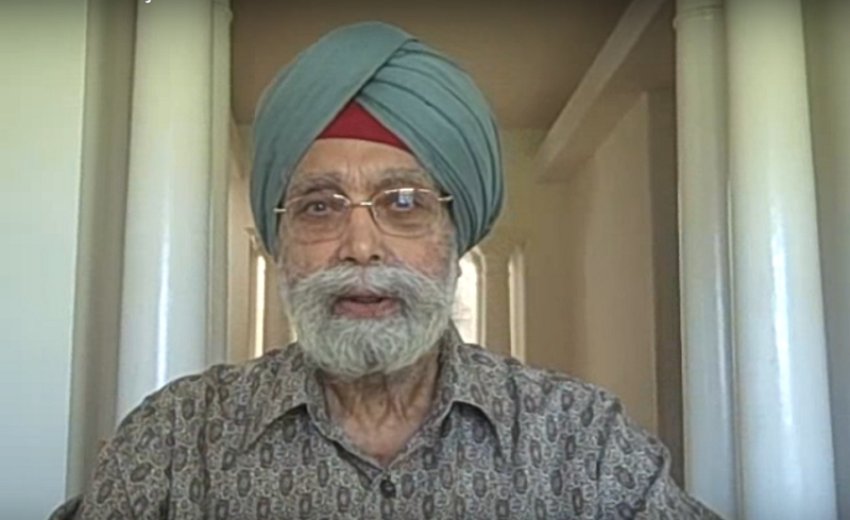My Memories and Anecdotes of Jaswant Singh Neki (1925-2015)
Dr. Jaswant Singh Neki had been my close colleague for almost a decade during the formative years before I migrated to the US in 1956. I continued to remain in close touch with him and visited him in India whenever I could.
In spite of long the intervals, I never forgot the vivid radiance on Neki Ji’s face and his kindly disposition towards me. Therefore, at his departure for the Timeless Journey, as we recognize death in our tradition, it is an almost sacred obligation to honor Neki Ji’s memories with several anecdotes recalled here from my memories.
Our earliest association was in Haripur, a small town in the northwest frontier province, so named by Maharaja Ranjit Singh to honor his great general, Hari Singh Nalwa. There was a small community of Sikhs in this Muslim majority area in the NWFP. It is the main city of the Haripur District in Hazara, now Khyber Pukhtunkhwa of Pakistan, with Swabi and Buner to the west, some 65 km north of Islamabad and 35 km south of Abbottabad.
Jaswant Singh Neki grew up in Quetta, a town only a few miles from Haripur. Haripur was built as a fortress surrounded by a wall 12 feet thick and 50 feet high which had only four entrances. That fort later became the city police station and housed the local government offices. Several miles to the south of Haripur is the ancient Buddhist university town of Taxila. There was no high school established for Sikhs in Haripur. Then a transformation occurred. After his graduation, Sardar Mohan Singh developed a High School curriculum for Sikhs and it so happened that a Sehajdhari Sikh came with an offer to build this school.
Bhai Lakshmi Chand, a prominent contractor and real estate developer of the Hazara District was a keen philanthropist. He won a contract to build railway tracks from Taxila to Havelian, which consequently not only brought wealth to Bhai Sahib, but there were sizeable stockpiles of left-over material suitable to build a school.
Bhai Lakshmi Chand not only made the school building possible he also helped to furnish it. He also provided the much needed startup funds for its operation. The managing board proposed to name the school as Lakshmi Chand High School after its chief beneficiary, but he would not consider any such proposal. Eventually the school was called Bhai Lakshmi Chand Khalsa High School.
One of the memorable students at the Khalsa High School was Ayub Khan, who grew up in the area. He was transferred from his earlier Islamia School of Haripur to the Khalsa School because of the latter’s higher educational standards. In the years to come, Ayub Khan was to join the Army, become a General, and eventually in 1958 take over as the President of Pakistan.
Sikh Students Federation Founded
It was at Haripur that Sikh students founded first the unit of the All India Sikh Students’ Federation (AISSF), and it is a fact actually owing to Ayub Khan’s persistent pleas for educated Sikhs to organize and help their community in the challenging circumstances that would follow when the British would leave India.
In 1944 a meeting was held in the orchard adjoining the school where the Sikh Students Federation was founded. Besides me, there were four other students who were its founding members: Manmohan Singh Kohli, Gurbachan Singh, Harbans Singh Nanda and Harbhajan Singh. We drafted a news item to send to the Sikh press as well as to the SGPC. Soon after the news was published, Dr. Gopal Singh Dardi, who edited and published the first ever English Sikh weekly, The Liberator, wrote to us about the AISSF being formed in Lahore. We immediately responded to become the Hazara Unit of that AISSF
My First Meeting with Neki Ji
Manmohan Singh Kohli, Gurbachan Singh and I traveled to Amritsar to participate in the General Body meeting to be held in Amritsar in the winter of 1945, where I acquainted myself with fellow students including Sarup Singh, Amar Singh Ambalvi, Jaswant Singh Neki and Satbir Singh along with his elder brother Inderpal.
 |
| A young Dr Jaswant Singh Neki at the Forman Christian College in Lahore, in the early 1940s. |
During my stay in Amritsar, we also made friends with several Akali leaders. Our relationship with the AISSF and friendship with the Akali leaders was abiding. Not long thereafter, Sikh leaders Giani Kartar Singh and Sardar Amar Singh Ambalvi travelled to Haripur to visit us there.
I recall meeting various Shromni Gurdwara Parbandhak Committee (SGPC) leaders when they were deliberating on ways to augment the Sikh population in the bordering districts for better representation of the community in various legislative bodies. SGPC undertook to attract Sehajdhari Sikhs to register as Sikh voters. It also recruited missionaries to attract Punjab and UP populations towards Sikhi which would enlarge Sikh voter base. AISSF volunteers were asked to design a manual for those missionaries to guide the newly converted Sikhs in establishing newer congregations.
The general body of the SGPC approved the final draft of Raho Reeti document on 3 February 1945, later to be known as the Sikh Rehat Maryada, and appointed an eight member subcommittee to refine it where necessary. In view of the urgency, the printers were asked to print the document as available as soon as possible with help from Sikh intelligentsia as represented by the AISSF.
I recall a typesetter at the SGPC printing press bringing proof of the draft of the Rehat Maryada for correction to Jaswant Singh Neki late at night. Neki ji was preoccupied in drafting something for the AISSF General Meeting. Satbir Singh and I were present at the time and Neki Ji assigned the task to us.
I clearly recall Satbir and myself making three major corrections besides the type setting errors and took the documents to Neki Ji for double checking. We made sure that Ardas had appropriate wording so the Guru Granth as installed did not become a physical object of Puja or worship. We also made sure that any type setting error was not interpreted to exclude Sehajdhari Sikhs in the definition of a Sikh. There was something regarding lavan procedure in Anand Karaj that needed proper wording. Neki Ji accepted all corrections. This was my first experience of working with Neki Ji and getting aware of his immense knowledge about Gurmat and commitment to Sikhi.
Neki Ji as Editor of the Daily Prabhat
Dr. Jaswant Singh was elected President of the AISSF on 20 November 1948 and remained so until 28 January 1950. He was at the time completing his studies at the Amritsar Medical College and AISSF was still in formative years. It was actively reaching various schools and colleges to establish its units. It was also the time when the Sikh community was plunging into a crisis. On 21 February 1949, Master Tara Singh was arrested at Narela railway station, near Delhi and sent to Almora jail. That news was followed by wide spread protests and police actions, the cops even entering the Golden Temple premises to make arrests. Several Akali and AISSF workers were arrested or forced to go underground to continue to lead the struggle.
Before his arrest, Master Tara Singh had taken over the Daily Parbhat newspaper published in Urdu, for disseminating his policies and programs. However, he did not have time to appoint permanent editorial staff. Moreover, he feared that the editor of the Parbhat could be arrested to stop the Akali Dal from disseminating their cause among the public.
After much consideration, he appointed Dr. Jaswant Singh Neki as Parbhat’s editor and me to assist him as both of us were well-versed with Urdu and more pertinently, were not under police’s radar for possible arrest.
I asked Neki Ji how he would manage his studies, duties at the hospital and still edit a daily newspaper and likewise how assisting him would impact my studies at Amritsar. In his typical calm and composed manner he assured me that divine Guru “would take care of those matters”.
When the AISSF appointed me as its Public Relations Secretary (‘Propaganda Secretary’ was the exact title), working with Neki Ji became my official responsibility. Neki Ji in turn worked at the hospital for his education and training, but also spent nights writing editorials and news articles for the daily newspaper as it had to be at newsstands all over entire northern India in the early hours of the morning. This was all besides a full time job of expanding AISSF.
Neki Ji’s diligence and discipline were exemplary as he completed editorials for the newspaper a few hours before dawn. The editorials had to be motivational for the community and much thought went into their compilation. I remember two editorial headings to this day: ‘Khatre-ki-Ghanti’ or ‘Bell of Danger’ to alert the Nation about the dangers to its future, and ‘Giani Kartar Singh ne kafir honay se pehley kya kaha’ (What did Giani Kartar Singh say before he became a kafir). This referred to Giani Ji’s leaving the Akali Dal to join the Congress Party and Neki Ji deeming that akin to becoming a kafir: an infidel who abandons his commitments or loyalties.
Training Sikh Youths
It was also in 1949 that the AISSF began Annual Training Retreats for Sikh students in order to provide leadership training. The first of those retreats were held at Paonta Sahib followed by some at Kanda Ghaat and thereafter at other places in India.
The choice of Paonta Sahib was inspired with its origins, Guru Gobind Singh having founded this town on the banks of the river Jamuna in 1686 and then inviting 52 scholar poets to serve at the Guru’s court. Mata Gujari had stayed there for three years and the Guru’s elder son, Baba Ajit Singh, was born there.
Guru Granth Exegesis
Sardar Sarup Singh was the Camp Principal with Sardar Amar Singh Ambalvi as Vice Principal (who specialized in political affairs); Dr. Jaswant Singh Neki (on religious studies); Sardar Satbir Singh (Sikh History) and Harbans Lal (on leadership) were the Course Directors for the AISSF retreats. Dr. Neki was also responsible for classes on Sikh religion and philosophy. In that capacity he asked Satbir and me to learn to perform the Guru Granth exegesis. I was only 18 at the time and Satbir was even younger. After some preparation I commenced with the exegesis.
I recall the subject of two of the exegeses I performed at the retreat. I was nervous but was confident under the tutelage of Neki Ji and Satbir; Sardar Sarup Singh boosted my confidence. My first public exegesis was of the Sabd on page 12 of Sri Guru Granth Sahib (SGGS), ਭਈ ਪਰਾਪਤਿ ਮਾਨੁਖ ਦੇਹੁਰੀਆ ॥ ਗੋਬਿੰਦ ਮਿਲਣ ਕੀ ਇਹ ਤੇਰੀ ਬਰੀਆ ॥ The second public exegesis was of the Sabd on page 175 ॥ ਕਿਨ ਬਿਧਿ ਕੁਸਲੁ ਹੋਤ ਮੇਰੇ ਭਾਈ ॥ ਕਿਉ ਪਾਈਐ ਹਰਿ ਰਾਮ ਸਹਾਈ ॥੧॥ ਰਹਾਉ ॥
Experience on the Shimla Mall
The AISSF had enrolled potential students and made arrangements at Kanda Ghat for this Camp. AISSF always paid for the transportation of the trainees as well as the cost of trainees’ boarding and lodging. Panthic organizations under the leadership of Master Tara Singh underwrote those costs.
A week before this camp, Masterji walked into my residence at the Sikh Missionary College Amritsar and asked me to inform AISSF officials that he would not be able to bear the expenses of the youth retreat as he had also undertaken to train workers to help the Akali Dal in the forthcoming elections for legislative bodies and needed funds for them.
I panicked and rushed to Neki Ji’s hospital quarters to convey Masterji’s message. We then both cycled to Sardar Sarup Singh’s residence for an urgent meeting. There we resolved to continue with the plans for the retreat at Kanda Ghat and to seek necessary financial support directly from the Sikh public.
As a result of this situation, Satbir Singh and I were deputed to Simla for collecting much needed funds whilst the camp was in progress. We would visit Sikh families in Simla and in our desperation request tourists and local Sikh residents who would be strolling along the Mall Road for contributions in our desperation. I remember visiting Mrs. Mohan Oberoi at her Hotel suite and Bhai Sahib Bagrian at his summer residence for the same purpose. Maharaja of Patiala, Yadavindra Singh, who had summer palace at Kanda Ghat, made an afternoon visit to the Retreat and committed some financial help.
Although it was hectic traveling between Kanda Ghat and Shimla on a daily basis by public transportation and then to the Mall with virtual ‘begging bowls’ all day long, we learned much from that experience. We learned how to successfully communicate with the Sikh public about the Aims and Objectives of the AISSF and the value of preparing the Sikh youth to serve the nation building causes.
Neki Visited Texas
Neki Ji visited US often. Twice, he stayed with me in our Texas home. Once, Thanks-Giving Square received him as a member of the Sikh delegation to the Millennium Assembly of the World Religious Leaders in year 2000. Neki Ji, Sardar Harbhajan Singh and I constituted the Sikh delegation representing the World Sikh Council and Akal Takhat Amritsar. On another occasion, I introduced Neki Ji to the Sikh community in Texas. He addressed the Sunday Diwan at the Gurdwara North Texas Sikh Temple. He spoke there for 30 minutes and the listeners were spellbound. During his presentation on Universal Sikhi, Neki Ji paused for a moment and asked the audience, “Bolo jee Waheguru”. As usual about half the congregation responded. After a few minutes, he again asked the congregation to utter “Bolo ji Ram Ram”. This time no one responded. He used this as an illustration to impress upon the listeners how biased they were in discriminating among God’s many names that our Guru, Sri Guru Granth Sahib, endorsed. Certainly he was a great orator.
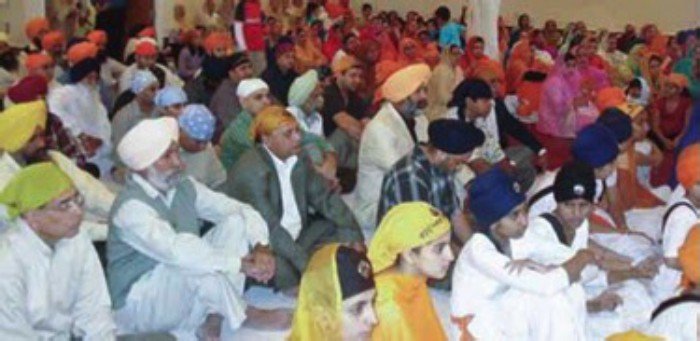 |
| Dr. Jaswant Singh Neki addressed the sangat in Dallas, Texas. |
All India Sikh Student Federation salutes Neki Ji
As the Sikh Nation celebrates the life of Dr. Jaswant Singh Neki, the AISSF family joins the Sikh nation in offering their eternal tribute to their departed leader. Working with Sikh youth, Dr. Neki was a leader par excellence. Neki Ji spent major parts of his life training and leading Sikh youth spread all over India and abroad. In my tributes, I would repeat that Dr. Jaswant Singh Neki was no ordinary Sikh. He was a tireless champion of Sikh causes, an encyclopedia of the wisdom of Sikhi, and a beacon for us all.
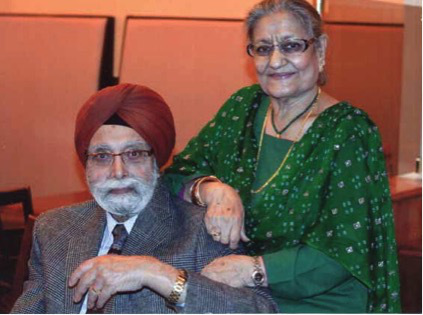 |
| Dr Jaswant Singh Neki and Sardarni Kanwerjit Kaur Neki |
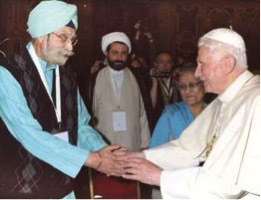 |
| Dr Jaswant Singh Neki seen with the Pope |
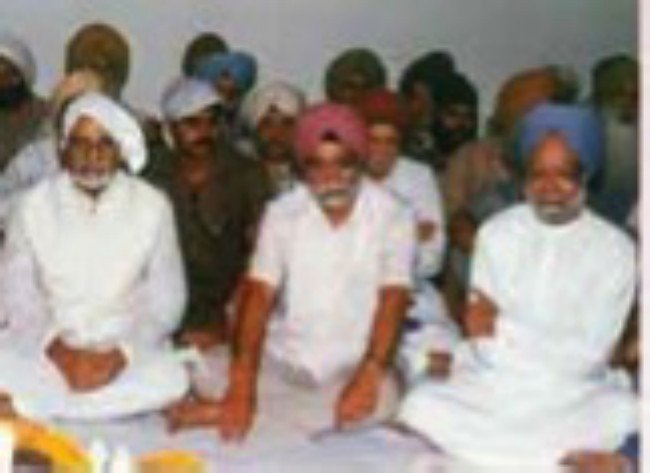 |
| Dr. Neki sitting between two prime ministers of India |

